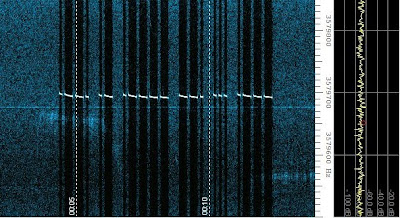Cheap single channel QRSS gear
With my 30m d.c.-receiver now running successfully for months, it would be time, I though, to "design" dedicated receivers (transmitters) for some more bands. The basic idea will follow the 30m-Polyakov design, just not using a canned oscillator this time. (for the schematics, please have a look at my web-page http://www.qsl.net/dl1gsj/).
40m version 1 (7059,9kHz)
Jan's comment on my 40m RX ideas brought me to the conclusion, that it would be desirable to use 3.530MHz crystals for a Polyakov receiver, additionally, with a slightly different pull, the same oscillator could be used in a transmitter design with a frequency doubler. When going for an active doubler, it could be switched off, so no carrier will be present during RX.
The downside, no side-band filter, which, in this portion of the band, seems crucial to me.
There is hope however, Rich offers a 7.058MHz crystal, which could be used as a notch filter in such a receiver.
20m version 1 (14096kHz)
Rich also sells a crystal 7.050MHz, this could be used in a similar fashion as mentioned above for the alternative 20m frequency. Even having the same side-band problem as the above idea bit
no obvious solution to it. One could consider to receive in LSB such that the USB will be on the IBP-beacons, which could be an interesting addition...
Probably a superhet-RX with 10Mhz and 4.096MHz crystals would be the safer bet here; alternatively: 18.096MHz and 4.000MHz. In such a RX-TX combination, all oscillators could run the whole time.
40m version 2 (7000,8kHz)
Nick offers crystals for 3.500MHz, which make wonderful subharmonic local oscillators for 7000.8kHz. Additionally, there would be a 7.000MHz crystal available at box73.de, which could be used as a sideband filter, even though, I think, that 6999.2kHz would not be that crowded. Again, the L.O. could be used with an active doubler for TX....
20m version 2 (14000.8kHz)
As stated before, there is a 7.000MHz crystal available. Now, same concept as for the second version 40m. With a 14.000MHz crystal available (conrad), one could image a side-band filter... but, what will be on 13999.2kHz?
ConclusionsSeems that some crystals will have to be ordered in Florida, since 7059900Hz has priority with me and all crystals are available from one source.
Since no canned oscillators are available for, the idea would be a classic approach using transistors, hence no L.O.-xtal-filter, as in my 30m design, will be required.
ProspectsI have not tried it yet, but it sits on my workbench (30m version) quite some while now, using the subharmonic mixer in reverse for generating a DSB signal. With either passband or notch filters, a single side-band signal could be generated, just like in Gene Marcus' design of a 30m WSPR TRX. Could be used with an XORgan ;-)




















